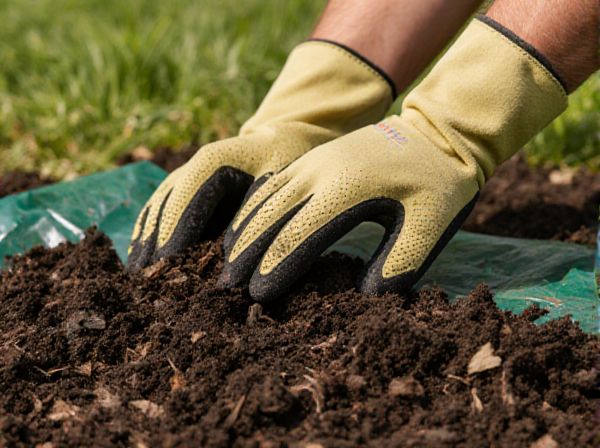
Sheet mulching vs landscape fabric Illustration
Sheet mulching enhances soil health by layering organic materials that decompose over time, naturally suppressing weeds while enriching the ground. Landscape fabric acts as a physical barrier, preventing weed growth but can restrict water and nutrient penetration, potentially harming plant roots. Choosing between these methods depends on balancing long-term soil enrichment against immediate weed control needs.
Table of Comparison
| Feature | Sheet Mulching | Landscape Fabric |
|---|---|---|
| Weed Control | Effective, natural barrier using organic layers | Physical barrier, blocks weed growth but may allow some seeds to germinate |
| Soil Health | Improves soil fertility by adding organic matter | No improvement; fabric is inert and may impede soil organisms |
| Moisture Retention | Excellent--organic layers retain moisture and reduce evaporation | Good--fabric allows water penetration but can dry soil faster than mulch |
| Longevity | Temporary--decomposes over months to years | Long-lasting--synthetic fabrics last several years |
| Installation | Requires layering cardboard/newspaper and mulch; labor-intensive | Simple to lay and secure; faster installation |
| Cost | Low cost using recycled materials and organic mulch | Moderate to high depending on fabric quality |
| Environmental Impact | Eco-friendly; biodegradable and soil-enhancing | Potentially harmful; synthetic fabric can contribute to plastic waste |
Understanding Sheet Mulching: Basics and Benefits
Sheet mulching is an organic gardening technique that suppresses weeds by layering biodegradable materials such as cardboard, newspaper, and compost directly on the soil, enhancing moisture retention and soil fertility. Unlike landscape fabric, which is a synthetic barrier that blocks weed growth but can hinder water and nutrient penetration, sheet mulching improves soil health by gradually decomposing and enriching the earth beneath. This method promotes a natural ecosystem, reduces the need for chemical herbicides, and supports sustainable weed control in garden beds.
What Is Landscape Fabric? Key Features and Uses
Landscape fabric is a woven or non-woven polypropylene material designed to block sunlight and prevent weed growth while allowing air and water to pass through. Its key features include durability, breathability, and ease of installation, making it ideal for long-term weed control in garden beds, pathways, and under mulch. Common uses involve stabilizing soil, reducing weed competition, and improving moisture retention without chemically altering the soil environment.
Comparing Weed Suppression Effectiveness
Sheet mulching provides superior weed suppression by creating a thick, nutrient-rich barrier that blocks sunlight and smothers weeds while improving soil health. Landscape fabric primarily acts as a physical barrier to weeds but can degrade over time and may allow some weed penetration through gaps or pests. Combining organic mulch on top of landscape fabric can enhance weed control but generally, sheet mulching offers a more sustainable and effective long-term solution for preventing weed growth.
Impact on Soil Health: Sheet Mulching vs Landscape Fabric
Sheet mulching enhances soil health by enriching organic matter, improving water retention, and promoting beneficial microbial activity, whereas landscape fabric often restricts airflow and water penetration, potentially leading to soil compaction and reduced microbial diversity. Over time, sheet mulching supports nutrient cycling and soil structure regeneration, while landscape fabric may inhibit these natural processes, causing decreased soil fertility. Gardeners prioritizing long-term soil vitality typically favor sheet mulching for its ecological benefits and sustainable weed suppression.
Installation Process: Step-by-Step Guide
Sheet mulching installation begins by clearing the area of existing weeds and spreading a layer of cardboard or newspaper to smother growth. Next, organic mulch such as compost or straw is layered on top to improve soil health and retain moisture. In contrast, landscape fabric installation requires securing a permeable synthetic barrier directly onto the soil, followed by adding a top mulch layer to block weed growth while allowing water and air to penetrate.
Long-Term Maintenance Considerations
Sheet mulching enhances soil health by gradually decomposing organic layers, reducing weed growth over time without the need for frequent replacements, making it a low-maintenance solution for long-term garden care. Landscape fabric provides an initial barrier against weeds but often requires ongoing upkeep such as repositioning and potential replacement due to tearing or soil accumulation, which can increase maintenance efforts over the years. Choosing sheet mulching supports sustained weed suppression and soil enrichment, minimizing labor and costs associated with long-term weed management.
Environmental Impact Assessment
Sheet mulching promotes soil health by enhancing organic matter and supporting microbial activity, reducing erosion and water runoff. Landscape fabric, while limiting weed growth, can impede soil aeration and disrupt natural decomposition processes, potentially leading to increased synthetic waste. Evaluating environmental impact favors sheet mulching for its sustainable contribution to ecosystem balance and reduced reliance on non-biodegradable materials.
Cost Comparison and Budget Considerations
Sheet mulching generally offers a more cost-effective solution for weed control compared to landscape fabric, as it utilizes inexpensive organic materials like cardboard and mulch. Landscape fabric requires an upfront investment in synthetic materials, which can be higher but may reduce labor costs due to easier installation. Budget considerations should factor in not only material costs but also long-term maintenance and replacement expenses associated with each method.
Best Scenarios for Using Sheet Mulching
Sheet mulching is ideal for transforming bare soil or heavily weed-infested areas into nutrient-rich garden beds by suppressing weeds naturally while improving soil health. This method works best in large, open spaces where organic matter can decompose in place, promoting moisture retention and encouraging beneficial microbial activity. Unlike landscape fabric, sheet mulching breaks down over time, making it a superior choice for sustainable, long-term gardening projects that prioritize soil regeneration.
When to Choose Landscape Fabric in Your Garden
Landscape fabric is ideal for long-term weed control in established garden beds where minimal soil disturbance is preferred, such as around perennial plants and shrubs. Its durability blocks sunlight effectively, preventing weed seeds from germinating while allowing water and air to permeate the soil. Choose landscape fabric when you need a low-maintenance solution that provides consistent weed suppression without the need for frequent replacement.
Sheet mulching vs landscape fabric Infographic

 gardendif.com
gardendif.com